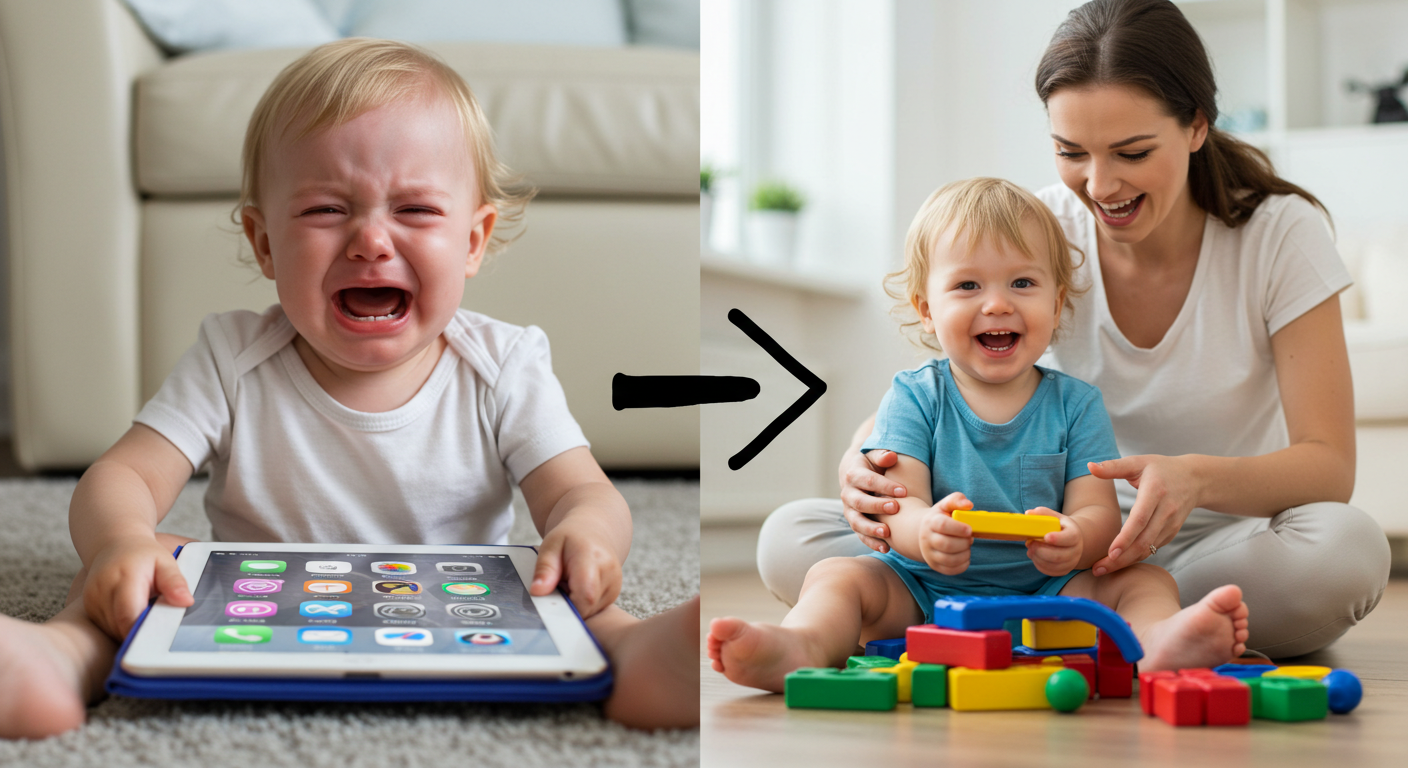
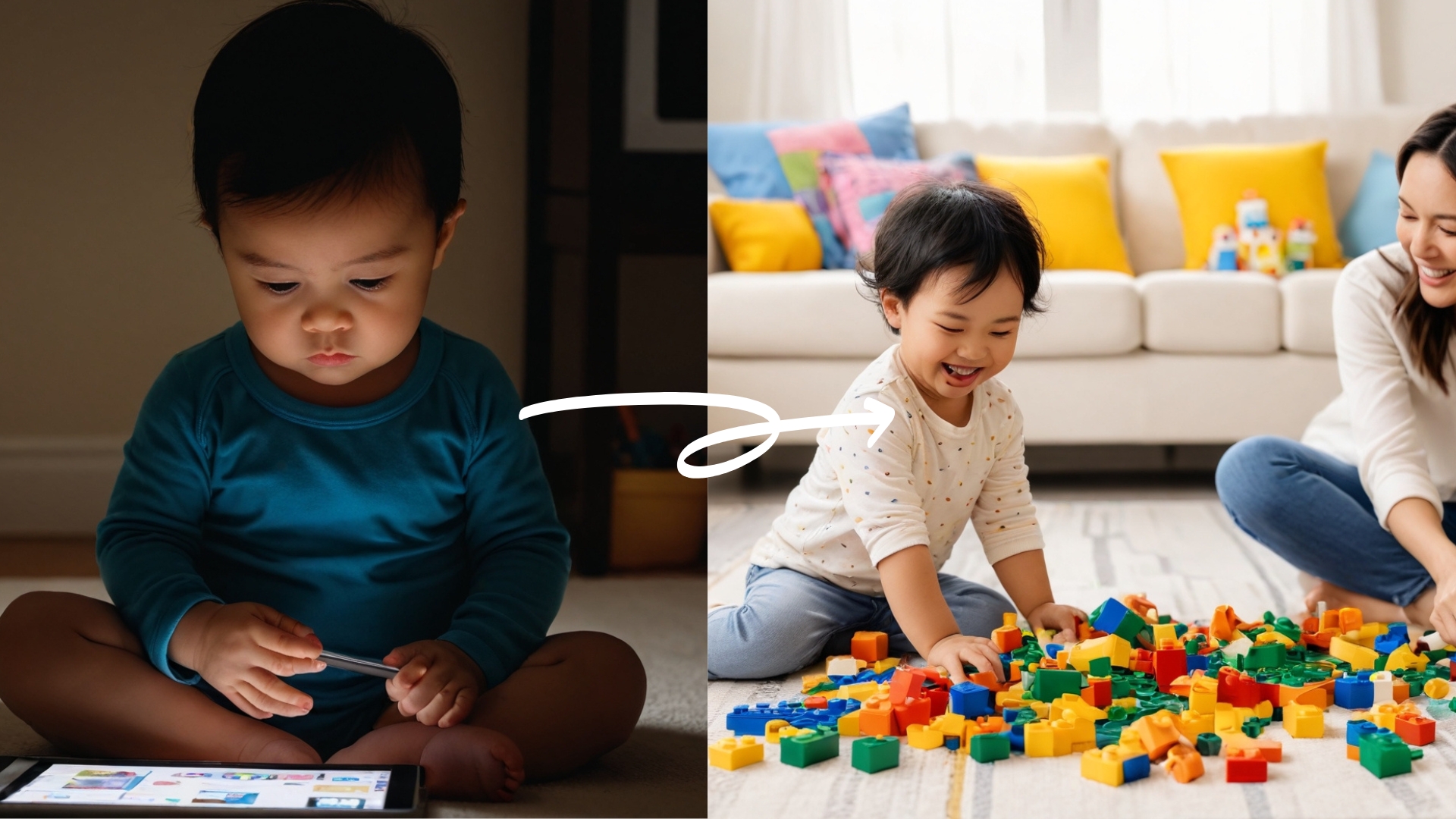
No More Screen-Time Battles: Enjoy Peaceful Evenings with Your Toddler
How to Finally Limit Your Toddler’s Screen Time Without Tantrums in Just 7 Days
Even if your little one is obsessed with the tablet and screams when you turn off the TV
The step-by-step method that’s transforming nightly toddler tantrums into calm, screen-free playtime in just one week.
"If I don't let him watch a show, I can't get anything done. But if I do, I'll face a huge meltdown when it's time to turn it off... I feel so stuck."
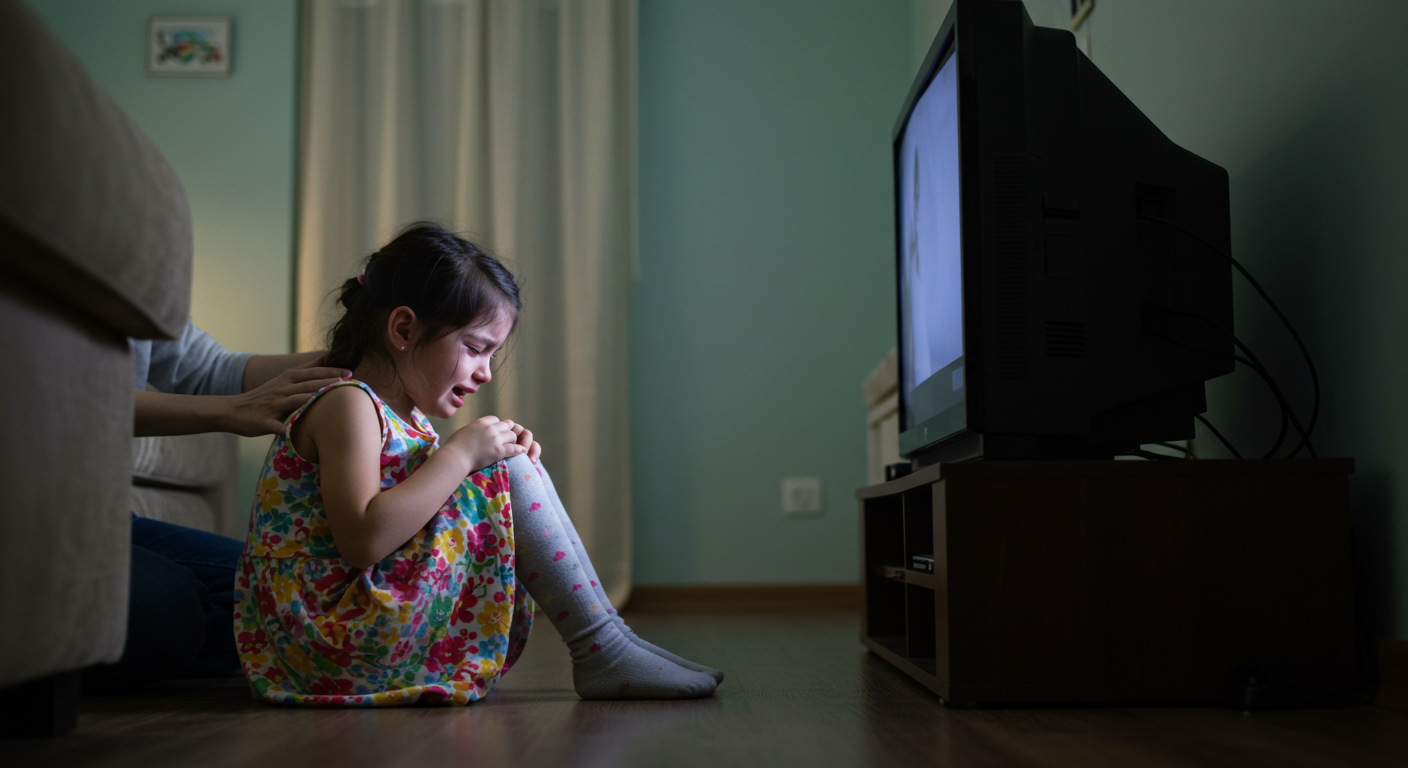
My Story
(and Maybe Yours Too)
I know exactly how you feel, because that was me. Every evening around dinner time, I’d face the same wrenching dilemma: turn on Mickey Mouse just so I could make dinner or answer a few emails, or else I'd endure an epic tantrum if I said no. There I was, a loving parent who hated relying on TV and tablets, yet I felt I had no choice. My toddler’s screams when screen time ended would shatter any peace in the house. I remember peeking around the corner, dreading the moment I’d have to say “time’s up” and brace for the inevitable meltdown.
I tried to balance it all — be an attentive parent while getting dinner on the table or finish my work — but the contrast between the calm before (him quietly glued to a show) and the chaos after (screaming when the screen went dark) was startling. I felt like a failure, caught between guilt and frustration. Guilty that I was using a screen as a babysitter just so I could finish a few tasks, and frustrated that whenever I tried to take it away, it led to a total meltdown.
What My Daily Struggle Looked Like
Battles every evening – the second I turned off the TV, my sweet 3-year-old would scream, cry, or even hit in protest. It often took 20 minutes to calm him down, leaving us both in tears.
“One more, one more!” – endless begging for “just one more show” or "set a timer". If I gave in, I felt manipulated; if I stood firm, I faced an epic tantrum.
Zero downtime for me – the only way I could cook dinner or take a work call was by handing over the tablet or turning on Mickey Mouse. I felt chained to screen time as my only babysitter, even though I knew it wasn’t healthy.
Morning meltdowns – some days, he asked for Bluey first thing in the morning. Saying “not now” led to a full-blown meltdown before 8 AM. What a way to start the day!
Constant guilt and worry – I knew too much screen time could harm his development, and I ached with guilt every time I saw him zoned out in front of a screen… but I was exhausted and out of ideas.
I Tried Everything Experts + Friends Recommended
Strict time limits and timers – I set a 30-minute timer on the iPad (why it failed: when the timer went off, it triggered the very tantrum I was trying to avoid)
“Educational” videos only – I swapped cartoons for learning apps (why it failed: he still protested just as hard when I ended screen time – ABCs or not, the tears flowed)
Going cold turkey – I attempted a no-screens-at-all week (why it failed: by day 2, I caved. I couldn’t get anything done and he became even more fixated on screens because they were suddenly forbidden fruit).
Bribes and rewards – I promised treats or stickers for ending screen time peacefully (why it failed: he was too young to really get it, and I was basically rewarding him for what should be normal behavior).
Distraction with toys – I’d shove toys in his hands the moment I turned off the TV (why it failed: he’d just throw them aside and wail for the TV to come back on).
Each night ended the same: a sobbing toddler, a half made dinner, and me feeling like the worst parent in the world. My lowest point came one evening when I actually hid in the bathroom after turning off the tablet, just to escape the screaming. Sitting on the floor behind a locked door, I felt defeated and ashamed. Was this really what parenting had come to? I remember whispering to myself, “Something has to change… I can’t live like this anymore.”
Then I Discovered Something That Changed Everything...
One day, a fellow parent friend noticed my struggles and shared a nugget of advice that sent me down a research rabbit hole. I devoured insights from pediatricians, child psychologists, and seasoned parents who had conquered this same problem
What I learned really opened my eyes and helped me understand why my child was having these meltdowns. Spoiler alert: It was no fault of his own.
According to child development experts, screens are essentially “hijacking” our toddlers’ brains. When a little one is glued to a video or game, their mind is in a pleasurable flow state – their brain is flooded with dopamine, the feel-good chemical. All is well… until you hit the off switch. Suddenly, that dopamine drops off a cliff, which can literally create a sensation of pain in their body as their happy hormone supply vanishes. This is why the instant the screen goes dark, the screaming begins – your child isn’t just “being difficult,” they’re actually hurting and overwhelmed by an abrupt emotional crash.
I also discovered:
Toddlers can’t just “get over it” – Unlike adults, toddlers haven’t developed the coping skills to manage big feelings of frustration or disappointment when the fun stops. Their brains are still learning to handle any transition, let alone one as stimulating as screen time. In their world, stopping Bluey midway feels like the end of the world because they literally find it impossible in the moment to cope with those emotions. No wonder we see temper tantrums – they truly need our help to come back to reality.
Traditional tactics backfire – I used to think a 5-minute warning or strict rule was enough. But even with a warning, an abrupt “time’s up” still yanks a child out of that hypnotic screen zone without relief. The research showed me why my “ok, all done now” approach led to screams anyway: I was effectively cutting off their dopamine supply in an instant. Simply put, our usual “just be consistent” or “set a timer” advice doesn’t work on its own because it doesn’t address the underlying brain chemistry.
The secret is in how you transition – The real game-changer was learning that you shouldn’t pull your toddler out of the screen world, but rather join them in it briefly and then guide them out gently. One clinical psychologist, Isabelle Filliozat, revealed a brilliant three-step technique: “enter your child’s world,” then “ask questions,” then “build a bridge back to reality.” Instead of simply shutting off the TV from across the room, you sit down next to your child and engage for a minute in what they’re watching. By doing this, you ease them out of the screen trance gradually. The dopamine in their brain doesn’t drop abruptly because you’ve created a bridge between the screen world and the real worldmother.ly. I was skeptical, but this made so much sense – and when I tried it, the magic happened: my child actually turned to talk to me about his show and even accepted when I said it was time to turn it off – with NO tears!
Consistency is key (and it starts with us) – Perhaps the hardest pill to swallow was realizing how my own behavior was sending mixed signals. Experts pointed out that if kids see us on our phones 24/7 or if one day we allow unlimited YouTube and the next day we don’t, we’re setting ourselves up for failure. I learned that having a solid plan that everyone in the family follows is crucial. Toddlers actually handle limits better when they’re predictable and universal (no more one parent saying yes to extra TV while the other says no).
But most alarming of all:
Most parents (like me) are unknowingly making the screen-time tantrums worse by how we react. I learned about the reinforcement loop – when we give a child a phone or tablet to stop a tantrum, we’re actually teaching them that throwing a fit is the way to get more screen time. In the moment, it feels like “whew, crisis averted.” But that relief is short-lived. The next time, they cry even louder and longer, because it worked before. I realized I was trapped in this vicious cycle: he’d scream, I’d give in just to calm him, which only guaranteed more screaming tomorrow.
I know because I was making all these same mistakes...
Through extensive research and consultation with pediatricians, child psychologists, and dozens of fellow parents, I discovered why all those traditional approaches fail – and more importantly, what actually works to fix this problem for good.
I took everything I learned and distilled it into a clear, step-by-step system for sanity-saving screen-time limits.


I call it the "Screens Without Screams" Method
By using a few counterintuitive techniques to work with my toddler’s brain instead of against it, I was able to
End the daily tantrums over turning off the TV – completely. (We’ve gone from nightly meltdowns to zero tears when screen time ends!)
Keep my toddler happily occupied with activities other than screens – so I can actually cook dinner or hop on a work call without feeling guilty or resorting to Cocomelon every time.
Eliminate my parent guilt around screen time – I now have a balanced plan, so when he does watch a little Sesame Street, I know it’s within healthy limits and part of a bigger routine. No more nagging worry that I’m “failing” him.
Enjoy peaceful, tantrum-free transitions – bedtimes and mealtimes no longer start with screams. My child calmly hands me the tablet when time is up, often with a smile or by redirecting himself to a toy (yes, this is possible!)
Feel back in control of my household – instead of dreading the next screen time battle, I feel confident and in charge. Our home is calmer, our interactions are more positive, and we’ve reclaimed so much quality time that used to be lost to screens.
And it wasn’t just my family. After helping dozens of other parents in my online mom group replicate these results, I’ve refined this approach into a simple method that anyone can use…
To truly stop screen-time meltdowns, you need more than just an timer – you need to develop a new set of parenting skills. Here are the four essential skills that separate families who enjoy peaceful screen-time routines from those stuck in daily battles:
4 Essential Skills for Tantrum-Free Screen Time (Most Parenting Apps Won’t Teach These)

Consistency & Boundaries – Setting clear, firm limits and sticking to them is crucial. Why it’s important: toddlers thrive on routine and knowing what to expect. (If you’re inconsistent – say yes to unlimited cartoons one day, then ban screens the next – they’ll push harder and meltdown more, because the rules keep changing.)
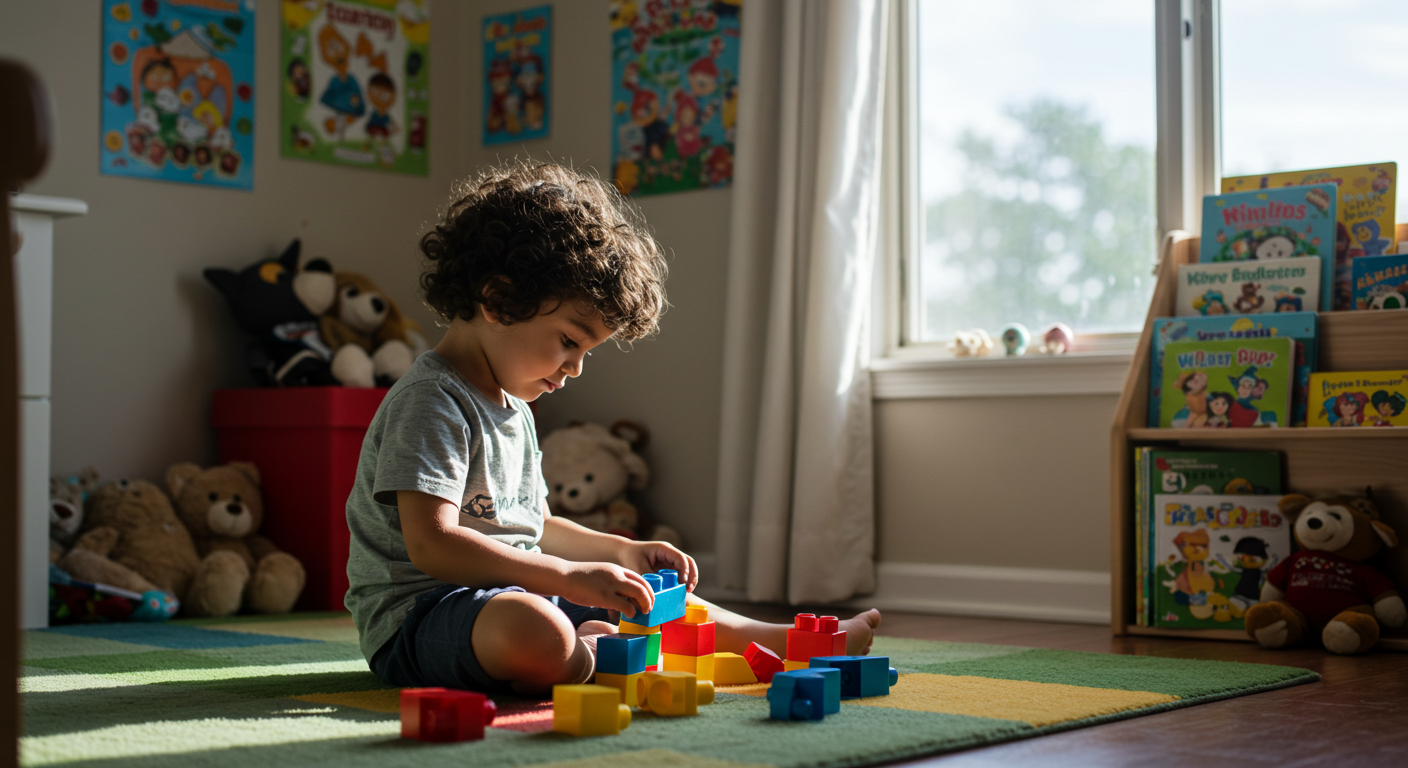
Creative Distraction & Engagement – Having a toolbox of screen-free activities and engaging alternatives at the ready. Why it’s important: the best way to pull a child away from a screen is to offer something else that captures their interest. (If you don’t provide fun alternatives, the tablet will always win – and you’ll end up giving in to stop the whining.)

Calm & Confidence – Developing calm authority in the face of tantrums, instead of reacting with anger or anxiety. Why it’s important: toddlers take their emotional cues from you. (If you stay calm and confident, tantrums die down faster; if you panic or get angry, it’s like adding fuel to the fire and the tantrum escalates.)
Instant Access – Start Your Tantrum-Free Transformation Today!
Here’s Everything You Get With “Screens Without Screams” Today!
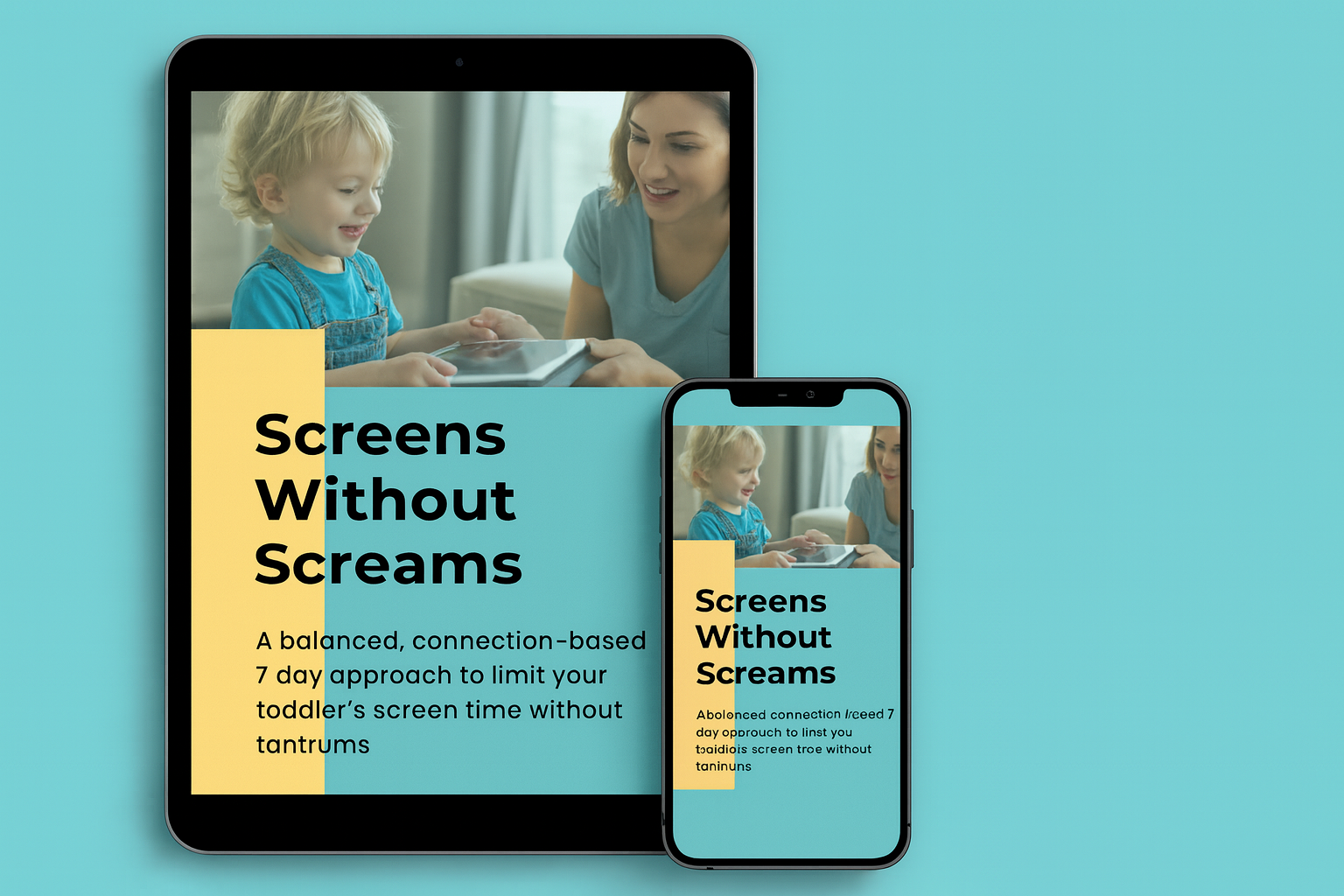
What's included:
The Complete “Screens Without Screams” Guide – A 25-page digital guide revealing my 5-step system to end screen-time tantrums. You’ll get proven strategies to solve your toddler’s screen-time struggles and restore peace at home, step by step. It’s like a blueprint for happier, calmer days (and it’s easy to read, even on a busy schedule!)
Plus These 5 Bonus Guides (FREE): Each bonus is a short section, targeting a specific mini-problem, so you have all the tools you need.
“Tantrum Tamer Toolkit” – 5 quick calming strategies to defuse screen-time meltdowns in the moment, so you can handle outbursts like a pro without giving in or losing your cool.
“Screen-Free Lifesavers: 20 Busy Toddler Activities” – A cheat sheet of 20 engaging, low-prep activities to keep your toddler happily occupied while you make dinner, answer emails, or just catch your breath – no screen required! (Goodbye, guilt; hello, productive peace and quiet.)
“Magic Transition Phrases” – Tried-and-true scripts and phrases for ending screen time without tears. Know exactly what to say (and how to say it) to help your child cooperate when it’s time to turn off the device – no more power struggles at shutdown time.
“United Front: Caregiver Consistency Guide” – Tips and scripts to get grandparents, babysitters, and your partner on the same page with your screen-time rules. Ensure everyone follows the plan so your toddler can’t play one caregiver against another (no more “But Grandma lets me!” headaches).
“7-Day Screen Detox Planner” – A gentle, step-by-step plan to reset your child’s screen habits in one week. This bonus shows you how to gradually dial back excessive screen time without tantrums, using fun substitutions each day. By Day 7, you’ll see a noticeable change – more play, less begging for the tablet, and a happier kid!
BEFORE AND AFTER
The Transformation You Can Expect
Don’t let constant screen-time battles continue dominating your home life. Your family’s evenings and routines can become calmer and happier than ever – you just need the right system to make it happen.

Before “Screens Without Screams”:
Chaos at every “screen off” time – yelling, crying, and 30-minute tantrums just to get your child off the tablet.
Relying on TV/iPad to babysit so you can cook, work, or simply take a shower – and feeling guilty about it every day.
A toddler who is glued to screens and asks for cartoons from morning to night, leaving you worried about their development.
Power struggles that leave you exhausted – you say no, they scream louder. You give in, and nothing really improves (in fact, it gets worse).
Feeling like screen time is in control of your household, not you – walking on eggshells, fearing the next meltdown.
Overwhelming parent guilt and frustration, wondering if you’re “doing it all wrong” but not sure how else to survive the day.

After “Screens Without Screams”:
Peaceful transitions – your toddler ends screen time without a fuss, often even turning off the TV on their own! No more daily battles at shutdown.
A balanced routine – you have go-to screen-free activities to keep your child happy and busy while you get things done, so screens become just one small part of the day (not the centerpiece).
A happier, more engaged child – now that screen time is in check, you see your toddler playing creatively, exploring toys and games, and even asking for story time or outdoor play instead of YouTube.
Confidence and control – you enforce gentle but firm limits and your child respects them. The whole family knows the plan, and there are far fewer tantrums about anything, not just screens.
A calmer home – no more ear-piercing screams over the iPad. Mornings, mealtimes, and bedtimes unfold with less stress and more cooperation, which means a happier child and a happier parent.
Guilt-free parenting – you finally feel good about how you’re handling screen time. No more constant guilt; you have a plan that works, and you see your child thriving because of it.
Your Tantrum-Free Journey Begins Here
The 5 sections To Transform Your Toddler’s Screen-Time Habits:
Each component of “Screens Without Screams” is carefully designed to rewire the screen-time routine using proven positive parenting approaches. You’re not just cutting back screens – you’re transforming how your child responds and how you manage those tricky moments, step by step.
Section 1: The Reset Mindset (Day 1)
Discover the eye-opening truth about why your child melts down – and instantly release the guilt you’ve been carrying. This first component helps you understand the science of toddler screen-time behavior so you stop blaming yourself or your child. You’ll feel empowered and prepared for change.
The hidden cycle driving your toddler’s screen addiction (knowing this will make everything else finally click).
A simple mindset shift to immediately ease your guilt and frustration – you’ll realize you’re not a bad parent and you’re not alone.
The #1 question to ask yourself whenever you feel tempted to hand over the phone – this will help you make a conscious choice instead of an automatic reaction.
Section 2: The Peaceful Turn-Off Technique (Immediate)
End screen sessions without tears using our gentle 3-step off-ramp. This is the heart of the method – a proven routine you’ll follow every time screen time is up, so your child cooperates instead of chaos
The exact 3-step “bridge” method to transition your child off screens – no more sudden unplugging that triggers screams
One “magic phrase” child psychologists recommend that instantly validates your toddler’s feelings (and dramatically reduces pushback at turn-off time)
A fun ritual to do right after the screen goes off that makes your child look forward to what’s next, instead of mourning the TV show they lost
Section 3: Screen-Free Solutions (Set Up in 1 Afternoon)
Keep your little one happily busy without relying on screens. You’ll create an environment and toolkit that naturally draws your toddler’s attention away from devices and into play and exploration.
How to build a “busy box” filled with irresistible activities that can hold your toddler’s attention for 20+ minutes – giving you guilt-free quiet time to cook or work.
15+ no-prep activities (sorted by age) that you can pull out at a moment’s notice when your child is bored or begging for the tablet. These are lifesavers for work-from-home days and dinner prep.
The art of toy rotation – a genius parenting hack to make old toys feel new and exciting again, so your child doesn’t immediately sprint to the screen for entertainment.
Section 4: Meltdown Mastery (Use Anytime)
Say goodbye to dread – handle any tantrum calmly and quickly. Despite our best efforts, meltdowns might still happen occasionally (we’re all human!). This component gives you a fail-proof plan to manage outbursts without yelling, bribing, or caving in.
A step-by-step “Tantrum Calm-Down” checklist to soothe your child (and yourself). Know exactly what to do and what NOT to do when a screen-time tantrum strikes, so you maintain control and shorten the storm
Phrases that comfort and phrases that inflame – learn the crucial dos and don’ts of what to say during a meltdown. (Example: why “You’re fine, stop crying” backfires, and what gentle words to use instead)
How to create a calm-down corner or safe space that your toddler can go to when they’re upset. This teaches them to self-soothe and shortens recovery time, setting the stage for better emotional regulation
Section 5: Consistency & Caregiver Alignment (Ongoing)
Make the plan stick (for you, your child, and everyone involved). This final component ensures long-term success by getting all caregivers on board and integrating the new habits into daily life. Say goodbye to mixed messages and hello to a unified approach.
Setting a family media plan in motion – simple tips to get your partner (or co-parent) on the same page so you’re not working against each other. Present a united front that your toddler can understand and respect
Polite but firm scripts for grandparents or babysitters who tend to spoil with screen time. Learn how to kindly enforce your rules with others, so one weekend at Grandma’s doesn’t undo a week’s progress
Staying on track during tough moments – what to do on those crazy days (travel, illness, etc.) when you do need to allow a bit more screen time. (Yes, life happens – this system shows you how to stay flexible without falling back into old habits or feeling guilty.)

